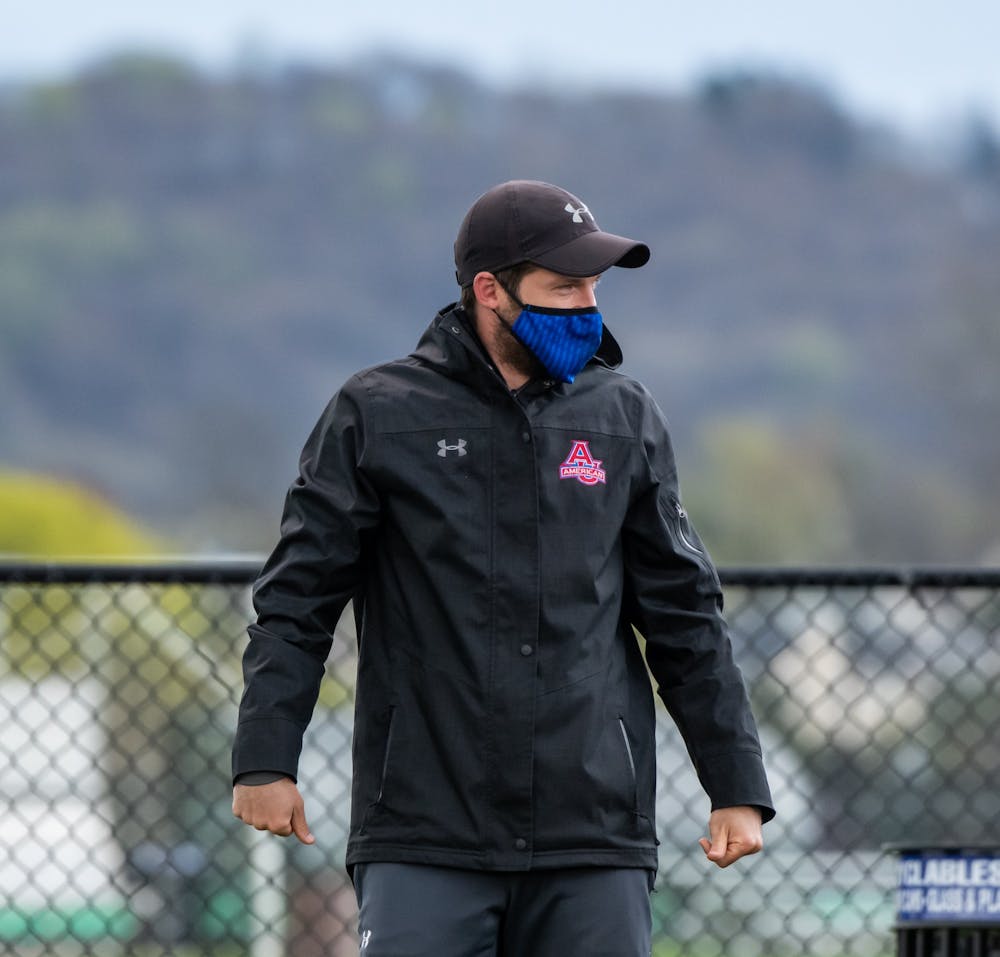Steve Jennings wishes he had access to sports science technology and advanced statistics when he was a player. Now, as the head coach of American University’s field hockey team, Jennings gets to implement these new elements into his coaching system and learn alongside his players.
“I would’ve loved it. I’m jealous of all the athletes today,” Jennings said with a laugh. “For video, we used to have a VHS and had to rewind it for different sports, and couldn’t really get stats. After every game, the players now get a video, which has all of their touches and all of their defensive plays all in one package instantly. Back in the day that was just not possible.”
The rise of sports science and analytics has infiltrated almost every sport worldwide, from the professional leagues down to amateur, college and high school sports. The teams at AU are no different, immersing themselves in data that gives acute insight into players’ bodies and playing styles. The data also helps coaches refine their tactics and practices, all to gain a crucial edge over their opponents.
Jennings’ introduction to sports science came through his time as a coach for the U.S. Women's National Team program. They worked with Catapult, a company whose data-rich wearable technology gives a detailed accounting of players’ movements, tracking how high or low they get to the ground or the speed they accelerate in different directions. Soon after, Jennings began to implement his newfound knowledge at AU.
Starting around the 2014 or 2015 season, the coaches began collecting data on the players’ heart rates, according to Jennings. Eventually, they started using a more advanced GPS technology called Polar, which tracked their speeds and workloads on the field.
“We had to collect data for quite a while before we could really do anything with it,” Jennings said. “We had to see ‘how much work is this drill?’ ‘How much work is this game?’ ‘What does the recovery need to be like?’ And over a period of time, you start to get patterns and you start figuring out how you play most effectively, and then you start building a practice based on those metrics.”
That plan begins with communication between the athletes and coaches. Some of the athletes come in with data tracking knowledge, but generally need time to digest the new information before they can convert it into on-field improvements.
“I think that people are not so aware of this from high school, outside of maybe a Fitbit or an Apple Watch,” Jennings said. “But they’re not used to it from a true hockey practice, hockey game live-tracking and those types of data points. And they are always excited about it. They see it as a real big advantage that we’ve been able to utilize against our competitors, and how to make sure we are at our peak performance levels come playoff time.”
Mike Montross, an assistant coach for AU’s men’s soccer team, said that the coaching staff has a variety of uses for Polar. Coaches can figure out each player’s stamina and slot them into designated “zones” during games, which helps them eliminate preventable injuries and make smart substitutions before anyone gets too exhausted.
“The players are more curious and look at the fun stuff like ‘How fast did I run?’” Montross said. “When we’re looking at it, we’re looking at how much high-speed running they are doing, changes in direction, accelerations and decelerations. Because that’s really where injuries are going to occur.”
Tracking average speed is important because sudden increase in high-speed running can lead to injuries when the hamstrings, quads and groins aren’t “primed for that consistent high speed,” Montross said.
While tracking heart rates and stamina levels during practice serves as the foundation for a lot of the sports science data, coaches still keep tabs on their athletes during the games. The staff has iPads that have five “heart rate zones” for the players on the field, which comes from their wearable technology.
When an athlete reaches or exceeds 90 percent of their maximum heart rate, they are placed in the red zone, an indicator that they may be too exhausted to play at the highest level. For a sport like soccer which is played on a large field and requires constant movement and running, coaches want to keep fresh bodies on the field and keep the team healthy.
But what happens when, in the heat of competition, a highly competitive player is visibly tired and should be substituted? How do you communicate to them that removing them is the best call, both for themselves and the team? For Montross, it is all about building trust between the staff and the athletes.
“We want to win and they want to win,” Montross said. “But you just have to be smart. If someone looks tired and we sub them out and they're like ‘Hey I feel fine,’ well this is what Polar is telling us. You’ve been in the red zone for the last seven minutes and you turned over your last two passes… They believe in the sports science, and that we want to win too.”
Jennings and the field hockey team, for instance, run an aggressive style of play. That means that their stamina tracking and their Xs and Os often work hand-in-hand.
“What we try to do is build a framework about what our ideal style looks like. And for us, that style is fast,” Jennings said. “It becomes exciting for them because they start to understand that our goal is fatiguing the opposition so that, in the last ten minutes of the game, we’re able to really take over the game with our style, fitness and energy.”
That balance between more traditional coaching tactics and the rise of sport-specific technology is something that Jennings continues to be mindful of when coaching his team. While some old-school, veteran coaches may push back on some of the new-school tactics, Jennings believes that each can work in tandem to maximize a team’s chance at winning.
“How much of coaching is science versus art?” Jennings asked. “I think you have to always have room for the art of coaching and not be driven completely by the metrics. There are times where perhaps you should take somebody out of the game, but because of the way they are particularly playing or the momentum of the game is, it's better to just push on. We believe in our tactics, and I think you can marry the tactics along with the science.”
Sports science is not the only way AU’s teams are diving into numbers to look for a competitive advantage. Analytics and advanced statistics also provide teams with information that goes beyond the eye test, helping coaches understand what their team does well, what they can do better and what they can integrate into their game plan.
“With COVID right now we don’t have it, but there are a bunch of companies out there where you can send them your games, and they’ll break it down statistically,” Montross said. “We’ll get every player's passing percentage after the game, every player's forward passing percentage too. Tackles won, tackles lost, headers won and lost.”
Montross says that they were using a company called InStat, who would provide the team with the analytics they were looking for. This season, the coaching staff has been breaking the game film down themselves to get those advanced metrics.
As the technology advances, Jennings and Montross acknowledged that their teams are in a quasi-arms race with opposing programs to coach their teams as effectively as possible through science and statistics. While the technology and numbers may be new, the idea of staying on the cutting edge and ahead of your competitors in sports is as old as time.
“As coaches, you’re always looking to find new ideas,” Montross said. “If you think you have all the answers, that’s when you get passed. You have to always look to be creative and to get better, technically, tactically, and certainly with sports science.”





